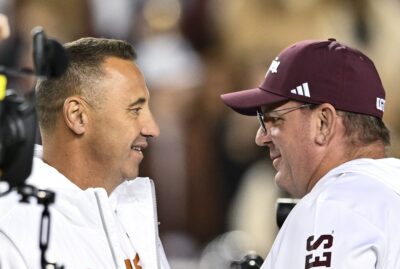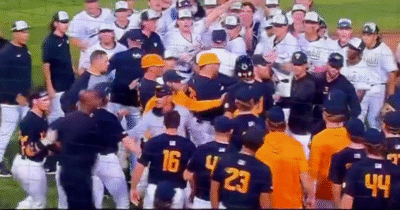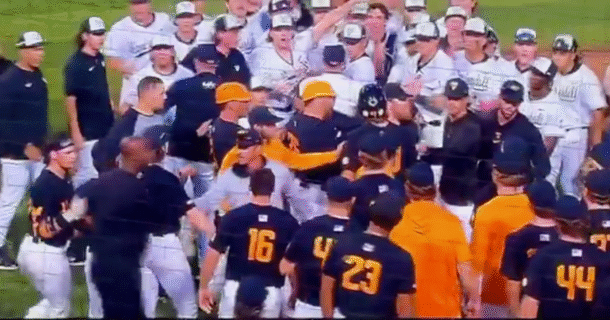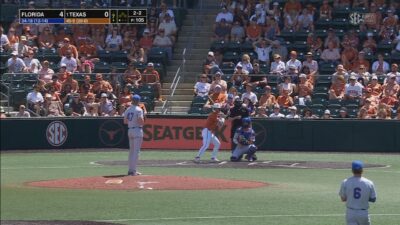Ad Disclosure

Let’s put a bow on 2021.
I get it. The season isn’t over yet. There’s work left to be done in bowl season, and in many ways, that’ll define the narrative for plenty of SEC programs heading into the offseason.
But before opt-outs, injuries, coaching changes and whatnot impact a neutral-site game played a month from now, I thought it’d be a fair time to evaluate what we learned about every team this year.
In terms of just the SEC as a whole, we learned that we can get through a season without any COVID-related cancelations. It wasn’t long ago that Greg Sankey stood at the SEC Media Days podium and warned everyone that vaccination numbers had to increase or else teams would be in danger of forfeits. So there’s that.
We also learned that just because you have an 8-figure buyout and you won a division title last year doesn’t guarantee you job security. Neither does delivering arguably the best season ever just 2 years ago. This is the SEC, and now, only 4 coaches from Week 1 of 2019 are still at their respective jobs.
Most importantly, we learned what targeting is.
Just kidding. Still working on that.
Here’s 1 thing I learned about every SEC team in 2021:
Alabama — An encore? It’s possible, but man, hold on to your seat
Considering how dominant Alabama was last year, it was safe to say that this 2021 group was never going to live up to that standard. We didn’t know that this squad would find itself in a 1-score game in 6 of 8 SEC contests. But hey, when you’re a team with holes, that’s what happens. Let’s call it what it is. Alabama has an all-world quarterback who occasionally makes mistakes out of inexperience, it has a makeshift offensive line that doesn’t hold a candle to past groups and it has a generational front-7 player in Will Anderson Jr. who often does far too much heavy lifting for the defense.
Fair?
We’ve seen moments where DeVonta Smith and Jaylen Waddle are missed, and other moments remind us how valuable Landon Dickerson was as the leader of the Tide. But having said all that, the Auburn game was a bit of a microcosm for the season. Again, Alabama played down to its competition. But all Nick Saban cared about was getting to Atlanta with a Playoff spot up for grabs. That’s exactly what the Tide have. In a year of craziness galore, that’s about all one can hope for.
Arkansas — Sam Pittman knows how to handle expectations, too
It’s one thing to rise above minimal expectations and win 3 games. It’s another to handle expectations and actually take that Year 2 jump. Pittman did both of those things by winning not 1, not 2, but 3 rivalry trophies. That doesn’t include beating Texas like a drum, either. Not all 8-4 seasons are created equal. I’d say Arkansas, which could now be in position to head to a Florida bowl game, absolutely rose above preseason expectations.
Pittman even weathered the storm after Arkansas again hit a midseason lull. For a team that was -180 in SEC play in 2019, consider this stat. Arkansas was at least within a touchdown — or up by much more than that — in the 4th quarter against every non-Georgia opponent on the schedule. That includes 1-score losses at top-10 Alabama and Ole Miss. That’s how you take a Year 2 step.
Auburn — New coaching staff, same Auburn roller-coaster
How fitting that it ended with a diabolical Iron Bowl script. Holding a 10-0 lead against Alabama late and finding a way to lose was, in many ways, the 1-step forward, 2-steps back approach for Year 1 of the Bryan Harsin era. You could’ve convinced yourself that someone stole Auburn’s uniforms in November. Four consecutive losses to end the season washed away a 6-2 start that had New Year’s 6 Bowl potential. Bo Nix looked like the best version of himself against the likes of LSU and Arkansas, but then crumbled against Texas A&M and MSU.
If the hope was that Auburn was going to elevate its floor and have a bit more year-to-year stability with Harsin, well, I’d say that went out the window. Blowing a 28-3 lead at home to MSU won’t be forgotten soon, and it probably didn’t help that the monumental LSU win in Death Valley came in a year when LSU was at its low point of the 21st century. There are major questions to answer moving forward. Does Harsin stick with Mike Bobo as his offensive coordinator? And after Derek Mason had a banner showing in the Iron Bowl, is he going to perhaps leave to become a head coach again? We don’t know. Both Bobo and Mason had wild seasons themselves.
It doesn’t feel like the roller-coaster is slowing down anytime soon.
Florida — The floor was lower than anyone could’ve imagined
If you paid attention when Dan Mullen got his contract extension in the offseason, you saw that the buyout stayed at $12 million. That was significant because it essentially meant that Mullen wasn’t safe from an implosion. Unfortunately for him, that’s exactly what we got. Not surprisingly, the defensive coordinator that Mullen brought back after the program’s worst defense since the Woodrow Wilson administration didn’t figure it out. Actually surprising was that Mullen’s hand-developed quarterback, Emory Jones, didn’t take off as a starter. Anthony Richardson appeared to be the better player, though you wouldn’t know it based on the way he was used.
Mullen picked up exactly where he left off in 2020. He got defensive in press conferences, and he watched the likes of Kentucky, South Carolina and Mizzou all humiliate him. Shoot, they out-recruited him, too. But Mullen will get to that in December. Some will look at Florida’s 2021 season and say that Mullen was fired for simply having 1 bad year. Losing 9 of 11 games to Power 5 competition and repeatedly sticking his foot in his mouth was why he was fired.
Sure, there were tempered expectations after losing Kyle Trask, Kyle Pitts, Kadarius Toney and Trevon Grimes. But nobody envisioned Florida would be fighting for bowl eligibility with an interim coach in the regular-season finale.
Georgia — We hadn’t seen the last of Stetson Bennett IV after all
The Mailman delivered yet another surprise to the Georgia faithful. The guy was the No. 3 quarterback on the depth chart in the spring, and when Carson Beck didn’t get the nod for an injured JT Daniels in Week 2, there was a “here we go again” with Kirby Smart. As in, he’s going to find a way to torpedo another national championship-caliber team because of his handling of the quarterback situation. But Smart’s infatuation with Bennett has been warranted.
Look beyond the 12-0 record. Why is Bennett different in 2021 than he was in 2020? He can actually execute Todd Monken’s offense. The Dawgs have been plenty capable of stretching the field, and Bennett’s willingness to call his own number on RPOs has proven to be a valuable asset. The only thing we don’t know about Bennett is if he can be like 2015 Jake Coker. That was the last time we saw a non-NFL starting quarterback win a national championship. Anything less than offensive brilliance at the quarterback position in the postseason and it’ll come back to Smart. But with UGA’s all-world defense, the jury is out on just how high of a level Bennett needs to execute in order to win it all.
Kentucky — The offensive transformation was a success
When Mark Stoops fired Eddie Gran and brought in Liam Coen, we knew the Cats were going to be a different team offensively. The days of finishing as the worst Power 5 passing offense were in the past. A big part of that was the transfer portal additions of Will Levis and Wan’Dale Robinson. Without them, Kentucky wouldn’t have been able to post its 2nd 9-win season since the Jimmy Carter administration.
Coen brought his Los Angeles Rams principles to Lexington, and while there were some bumps along the way (mainly that MSU game), it was absolutely the right move. A 52-point outburst against Louisville showed that even with a more balanced approach, Kentucky could still run the ball like it did under Gran. But seeing Levis connect with Robinson was unlike anything the Cats have had in recent memory. Robinson set the program’s receptions record and he’s closing in on the receiving yards record. Chris Rodriguez Jr., meanwhile, tied the program record with 8 100-yard rushing games.
Regardless of who stays and who goes, Kentucky established an offensive culture that should be the new standard moving forward. Now if only those turnover woes could correct themselves … but I digress.
LSU — The bounce-back year was doomed from the jump
If you didn’t sell your LSU stock after the UCLA opener, well, you’re braver than I was. Ed Orgeron insisted on playing a predictable defense, he tried to micromanage the offense and the injury bug bit early and often. The run game was nonexistent for the 1st half of the season, but by that time, the hay was already in the barn for Orgeron’s time in Baton Rouge. The adjustments didn’t come until SEC West contention was out of the question.
Having said all of that, how fitting was it that Orgeron made the unconventional decision to coach out the season and then get a made-for-TV sendoff. It felt like 2016 all over again. How else was it going to end other than Orgeron leading a comeback win to clinch bowl eligibility? But the fact that LSU was 5-6 was a byproduct of having a predictable offense that really didn’t find any sort of identity all year, especially after Kayshon Boutte went out with a season-ending injury.
Unfortunately for LSU, 2020 wasn’t just a championship hangover. A new era begins.
Mizzou — Tyler Badie was that dude
I can’t imagine Badie is going to do much of anything physical after the workload he got this year, especially down the stretch. I mean, the guy ended the regular season with 322 scrimmage touches. Just for a little perspective, 2015 Derrick Henry got 305 regular-season scrimmage touches. Like Henry, Badie’s workload was cranked up to a different level down the stretch. Look at his last 3 games:
- vs. SC: 34 carries for 209 yards, 5 catches for 22 yards
- vs. UF: 27 carries for 146 yards, 3 catches for -2 yards
- at ARK: 41 carries for 219 yards, 1 catch for -5 yards
- 3-GAME TOTAL: 102 carries for 574 yards, 9 catches for 15 yards
- 3-GAME AVERAGE: 34 carries for 191 yards, 3 catches for 5 yards
In that Arkansas game, he entered on short rest having gotten 69 total touches in the previous 2 games … and he carried the ball 41 (!) times. Insane.
Badie didn’t just have 11 times more carries than the next-closest Mizzou player. He also led the team with 54 catches, which was 18 more grabs than anyone on the roster. Not even Eli Drinkwitz thought that Badie would turn into a workhorse back in the post-Larry Rountree era, much less become one of the nation’s leaders in scrimmage touches. He was the entire offense. Until Mizzou’s defense played better down the stretch, Badie was the entire team. If Badie goes to the NFL, needless to say, Mizzou has a massive hole to fill.
MSU — Mike Leach’s Air Raid is now off and running
Yes, the Egg Bowl was disappointing. It was a weird 7-5 regular season, to say the least. Winning at places like Texas A&M and Auburn was a nice feather in Leach’s cap. Losing at Memphis — bad officiating or not — and needing an epic comeback just to beat Louisiana Tech at home was, well, not a feather in Leach’s cap. But the biggest takeaway from this strange season was that the Leach Year 2 bump happened. His offense is going to finish with a year-to-year improvement of at least a touchdown, which will mark the 3rd time in as many chances he accomplished that feat at Year 2 with a Power 5 program.
The other good news? Will Rogers is a stud. He deserved better in the Egg Bowl (those 3 drops in the red zone were baffling). Rogers is going to return as one of the country’s top signal-callers, and dare I say, MSU is going to have its pick of the litter when it comes to some talented transfer portal receivers. The offense worked in part because of Rogers’ brilliance, along with the additions of guys like Makai Polk and Jamire Calvin, but also because Charles Cross and that offensive line improved. No longer can defenses sit back in drop-8 coverage for 60 minutes and wait for a protection breakdown or a Rogers interception.
If MSU keeps Zach Arnett, there’s no reason why the Bulldogs shouldn’t start in the Top 25 in Year 3 with Leach.
Ole Miss — It turns out that actually playing defense changes your ceiling
We knew that Matt Corral/Lane Kiffin/Jeff Lebby 2.0 was going to be excellent. What we didn’t know was whether Ole Miss’ woeful 2020 defense could at least flirt with mediocrity in 2021. Tell ya what. Chance Campbell and Co. did more than just flirt with mediocrity. That group masqueraded as one of the league’s better units at times, including on Thursday night when a red-hot MSU offense was held to just 21 points in Starkville.
To say that this year’s Ole Miss defense was an improvement would be a wild understatement:
| Ole Miss defense | 2020 | 2021 (vs. P5) |
| Points allowed/game | 38.3 | 27.6 |
| Yards allowed/game | 519 | 446 |
| Yards/play allowed | 6.7 | 5.6 |
| Teams held under 35 | 5 (out of 10) | 7 (out of 9) |
| P5 teams held to 21 or less | 2 (out of 10) | 4 (out of 9) |
As a result, Ole Miss earned its best regular-season win total in program history. With the exception of Corral’s turnover numbers, the offense didn’t really change a whole lot from last year’s production. Campbell, Sam Williams, Jake Springer, Otis Reese and others became key pieces of this turnaround for what they did in Year 2 with DJ Durkin’s defense. Credit Kiffin for not jumping ship on that staff after a disastrous Year 1. Now they’re off to a New Year’s 6 Bowl in Year 2.
South Carolina — Shane Beamer can handle some in-season adversity
Think about this. I know the Clemson game was disappointing, but hear me out.
South Carolina was a 2-win team that ranked No. 125 out of 127 FBS teams in percentage of returning production. Beamer had never been a coordinator or a head coach, and he inherited that. He also lost his starting quarterback to injury and turned to his 3rd-string guy in November. Yet that team, which had a regular-season win total over/under of 3.5, made it to a bowl game.
That’s a win. Yeah, Beamer has some questions to address about the future of the offense. It really lacked an identity for the vast majority of the year, and it wasted a talented backfield. That’s a bummer. But clearly, that team plays for Beamer. It has definitely bought in, which we saw with home wins against Florida and Auburn. That’s progress. He’ll have a lot of key defensive players to replace, like JJ Enagbare and Jaylan Foster. But there’s a lot to like about a team that was clearly overmatched yet still found a way to reach the postseason.
Tennessee — Hendon Hooker can absolutely do everything Josh Heupel’s offense demands
Close your eyes, Tennessee fans.
I want you to go back to the spring when you were first seeing Heupel’s offense. You had no idea who QB1 was going to be. Harrison Bailey? Hooker? Kaidon Salter? Brian Maurer? Actually, QB1 for Week 1 wasn’t even there in the spring. Now let me tell you, spring Tennessee fan, that your team is closing in on a potential top-10 offense with a legitimate All-SEC candidate at quarterback.
Now open your eyes. Did you think I’d be talking about Hooker? If you did, did you think he’d be this good from the jump in Heupel’s offense? No way. The Virginia Tech transfer has been a revelation on Rocky Top. He has a legitimate shot to finish in the top 5 in FBS in quarterback rating while also finishing in the top 10 in rushing yards by a quarterback. Not bad for a guy who didn’t even win the job out of fall camp. Hooker has an NFL decision to make at the end of the year, but regardless of what that is for the veteran signal-caller, he was a huge proof of concept for Heupel’s offense in Year 1. Hooker succeeded despite not having the cannon of Joe Milton.
That should make Heupel more attractive on both the recruiting trail and in the transfer portal.
Texas A&M — Replacing Kellen Mond was a frustrating process
I’ve been saying this for a while now, so I apologize if A&M fans are sick of hearing it. I’d be fascinated to see A&M replay the season with Mond taking advantage of the free year of eligibility that 2020 provided. With those skill players and that defense? I truly think the Aggies are a 10-2 or 11-1 team. Instead, the Haynes King injury wasted a special group of talent in College Station.
That’s not necessarily a jab at Zach Calzada, who had moments of brilliance. Nobody can ever take that Alabama win away from him or Jimbo Fisher, who became the first former Saban disciple to take down the master. Aggie fans won’t forget that night anytime soon. But it was another 8-4 season that felt a bit hollow. Losing 4 SEC games and finishing conference play with a .500 record after a couple of November losses was eerily similar to the Kevin Sumlin era. Sumlin struggled to find his answer at quarterback in the post-Johnny Manziel era. As frustrating as Mond could be at times, he still helped engineer A&M’s best AP Top 25 finish in 81 years. Will Fisher struggle in the post-Mond era? It’s beginning to become a fair question.
Vanderbilt — A new coaching staff didn’t end the SEC losing streak, but …
Dare I say, the Commodores played like a different team in November. They covered 4 consecutive spreads to close the season, which isn’t necessarily something that Clark Lea is about to brag about in recruits’ living rooms, but it is a sign that Vandy figured some things out. Mainly on offense was where we saw the transformation with Mike Wright as the starting quarterback. He gave Vandy a bit of juice with the threat of his legs, and his connection with Chris Pierce Jr. really blossomed down the stretch.
Six of Vandy’s 9 games against Power 5 teams were decided by 3 scores or fewer. It’s going to be rough for the foreseeable future, but it felt like a much more competitive group than in 2020. Maybe that’s because the Dores were decimated by COVID-19 and injuries last season. Lea needs to develop and dig into the transfer portal to end Vandy’s SEC losing streak, which is now at 21.
Connor O'Gara is the senior national columnist for Saturday Down South. He's a member of the Football Writers Association of America. After spending his entire life living in B1G country, he moved to the South in 2015.







